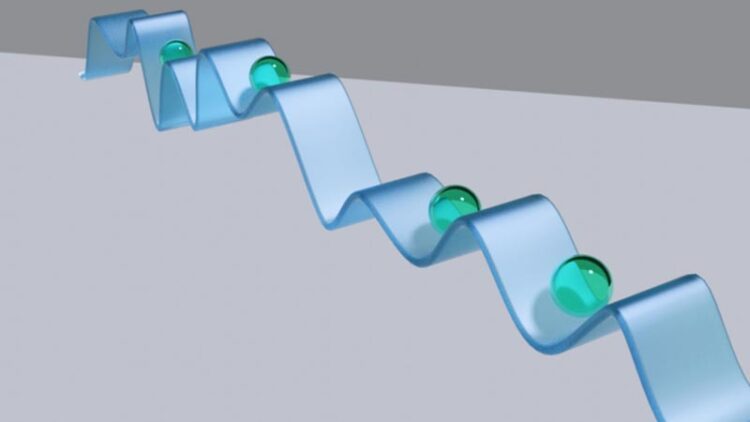Dynamical scaling of entanglement entropy and surface roughness in random quantum systems

Image of a random quantum system
Credit: Kazuya Fujimoto
Physicists demonstrate a dynamical one-parameter scaling, originally found in surface growth physics, in disordered quantum systems.
In physics, “universality” refers to properties of systems that are independent of their details. Establishing the universality of quantum dynamics is one of the key interests of theoretical physicists. Now, researchers from Japan have identified such a universality in disordered quantum systems, characterized by a one-parameter scaling for surface roughness and entanglement entropy (a measure of quantum entanglement).
Many-particle systems in the real world are often imbued with “disorder” or “randomness.” This, in turn, leads to the occurrence of phenomena unique to such systems. For instance, electrons in strongly disordered systems can become localized due to destructive interference, a phenomenon known as “Anderson localization.”
Anderson localization has been studied extensively in terms of one-parameter scaling, where system properties are scaled based on one specific parameter. But while most studies have focused on static properties, disorder can also significantly influence quantum dynamics such as entanglement dynamics and transport phenomena.
In a recent study published in Physical Review Letters, a team of physicists led by Prof. Kazuya Fujimoto from Nagoya University has now demonstrated numerically a dynamical one-parameter scaling called “Family-Vicsek (FV) scaling” for disordered quantum systems.
“While the FV scaling is originally known from classical surface growth, we found the scaling in random quantum systems by introducing a ‘quantum surface height operator’,” explains Prof. Fujimoto.
In their study, the physicists considered a system of non-interacting spinless fermions in a disordered one-dimensional potential for three common models. They found that the surface roughness followed FV scaling characterized with three exponents. Further numerical analysis showed that the surface roughness could be related to the entanglement entropy (EE), thus indicating an FV-type scaling for EE. In addition, they observed anomalous scaling exponents for one of the models and attributed it to the presence of localized states in a delocalized phase, a classic signature of quantum disordered systems.
Importantly, surface roughness can be measured experimentally for cold-atomic systems using microscopy techniques, which makes the experimental estimation of EE viable in non-interacting fermions.
“These findings will deepen our understanding of nonequilibrium physics and provide a novel viewpoint to classify the universal non-equilibrium phenomena emerging in random quantum systems,” says Prof. Fujimoto.
While the findings of the study do not have a direct influence on our daily lives, they certainly pave the way for a better understanding of real-world quantum systems.
The paper, “Dynamical Scaling of Surface Roughness and Entanglement Entropy in Disordered Fermion Models,” was published in the journal Physical Review Letters on August 23, 2021, at DOI: 10.1103/PhysRevLett.127.090601.
About Nagoya University, Japan
Nagoya University has a history of about 150 years, with its roots in a temporary medical school and hospital established in 1871, and was formally instituted as the last Imperial University of Japan in 1939. Although modest in size compared to the largest universities in Japan, Nagoya University has been pursuing excellence since its founding. Six of the 18 Japanese Nobel Prize-winners since 2000 did all or part of their Nobel Prize-winning work at Nagoya University: four in Physics – Toshihide Maskawa and Makoto Kobayashi in 2008, and Isamu Akasaki and Hiroshi Amano in 2014; and two in Chemistry – Ryoji Noyori in 2001 and Osamu Shimomura in 2008. In mathematics, Shigefumi Mori did his Fields Medal-winning work at the University. A number of other important discoveries have also been made at the University, including the Okazaki DNA Fragments by Reiji and Tsuneko Okazaki in the 1960s; and depletion forces by Sho Asakura and Fumio Oosawa in 1954.
Website: https://en.nagoya-u.ac.jp/
Journal: Physical Review Letters
Method of Research: Computational simulation/modeling
Subject of Research: Not applicable
Article Title: Dynamical Scaling of Surface Roughness and Entanglement Entropy in Disordered Fermion Models
Article Publication Date: 23-Aug-2021
All latest news from the category: Physics and Astronomy
This area deals with the fundamental laws and building blocks of nature and how they interact, the properties and the behavior of matter, and research into space and time and their structures.
innovations-report provides in-depth reports and articles on subjects such as astrophysics, laser technologies, nuclear, quantum, particle and solid-state physics, nanotechnologies, planetary research and findings (Mars, Venus) and developments related to the Hubble Telescope.
Newest articles

An Endless Loop: How Some Bacteria Evolve Along With the Seasons
The longest natural metagenome time series ever collected, with microbes, reveals a startling evolutionary pattern on repeat. A Microbial “Groundhog Year” in Lake Mendota Like Bill Murray in the movie…

Witness Groundbreaking Research on Achilles Tendon Recovery
Achilles tendon injuries are common but challenging to monitor during recovery due to the limitations of current imaging techniques. Researchers, led by Associate Professor Zeng Nan from the International Graduate…

Why Prevention Is Better Than Cure—A Novel Approach to Infectious Disease Outbreaks
Researchers have come up with a new way to identify more infectious variants of viruses or bacteria that start spreading in humans – including those causing flu, COVID, whooping cough…



